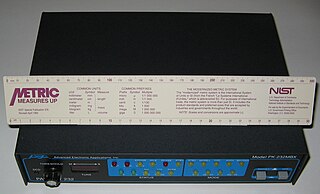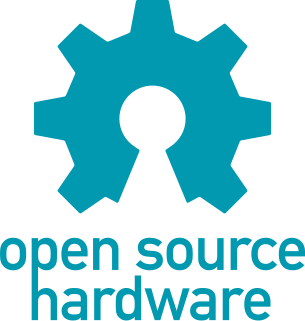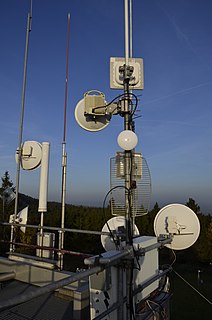Related Research Articles

Bruce Perens is an American computer programmer and advocate in the free software movement. He created The Open Source Definition and published the first formal announcement and manifesto of open source. He co-founded the Open Source Initiative (OSI) with Eric S. Raymond. Today, he is a partner at OSS Capital.

Packet radio is a digital radio communications method used to send packets of data. Packet radio uses packet switching to transmit datagrams. This is very similar to how packets of data are transferred between nodes on the Internet. Packet radio can be used to transmit data long distances.
Automatic Link Establishment, commonly known as ALE, is the worldwide de facto standard for digitally initiating and sustaining HF radio communications. ALE is a feature in an HF communications radio transceiver system that enables the radio station to make contact, or initiate a circuit, between itself and another HF radio station or network of stations. The purpose is to provide a reliable rapid method of calling and connecting during constantly changing HF ionospheric propagation, reception interference, and shared spectrum use of busy or congested HF channels.

Software-defined radio (SDR) is a radio communication system where components that have been traditionally implemented in hardware are instead implemented by means of software on a personal computer or embedded system. While the concept of SDR is not new, the rapidly evolving capabilities of digital electronics render practical many processes which were once only theoretically possible.
AX.25 is a data link layer protocol originally derived from layer 2 of the X.25 protocol suite and designed for use by amateur radio operators. It is used extensively on amateur packet radio networks.

Automatic Packet Reporting System (APRS) is an amateur radio-based system for real time digital communications of information of immediate value in the local area. Data can include object Global Positioning System (GPS) coordinates, weather station telemetry, text messages, announcements, queries, and other telemetry. APRS data can be displayed on a map, which can show stations, objects, tracks of moving objects, weather stations, search and rescue data, and direction finding data.

A terminal node controller (TNC) is a device used by amateur radio operators to participate in AX.25 packet radio networks. It is similar in function to the Packet Assembler/Disassemblers used on X.25 networks, with the addition of a modem to convert baseband digital signals to audio tones.

Open-source hardware (OSH) consists of physical artifacts of technology designed and offered by the open-design movement. Both free and open-source software (FOSS) and open-source hardware are created by this open-source culture movement and apply a like concept to a variety of components. It is sometimes, thus, referred to as FOSH. The term usually means that information about the hardware is easily discerned so that others can make it – coupling it closely to the maker movement. Hardware design, in addition to the software that drives the hardware, are all released under free/libre terms. The original sharer gains feedback and potentially improvements on the design from the FOSH community. There is now significant evidence that such sharing can drive a high return on investment for the scientific community.
PACTOR is a radio modulation mode used by amateur radio operators, marine radio stations, military or government users such as the US Department of Homeland Security, and radio stations in isolated areas to send and receive digital information via radio.

The AMPRNet or Network 44 is used in amateur radio for packet radio and digital communications between computer networks managed by amateur radio operators. Like other amateur radio frequency allocations, an IP range of 44.0.0.0/8 was provided in 1981 for Amateur Radio Digital Communications and self-administered by radio amateurs. In 2001, undocumented and dual-use of 44.0.0.0/8 as an internet telescope began, recording the spread of the Code Red II worm in July 2001. In mid-2019, part of IPv4 range was sold off for conventional use, due to IPv4 address exhaustion.

A computer network is a set of computers sharing resources located on or provided by network nodes. The computers use common communication protocols over digital interconnections to communicate with each other. These interconnections are made up of telecommunication network technologies, based on physically wired, optical, and wireless radio-frequency methods that may be arranged in a variety of network topologies.
D-STAR is a digital voice and data protocol specification for amateur radio. The system was developed in the late 1990s by the Japan Amateur Radio League and uses minimum-shift keying in its packet-based standard. There are other digital modes that have been adapted for use by amateurs, but D-STAR was the first that was designed specifically for amateur radio.
WINMOR is a radio transmission protocol intended to be used in the Winlink 2000 Global Radio E-mail System by amateur radio operators, marine radio stations, and radio stations in isolated areas. WINMOR complemented the PACTOR modes in the high frequency portion of the Winlink system, but since July of 2020 has been deprecated by Winlink.org in favour of other, now more modern and capable protocols, such as ARDOP.
The TAPR Open Hardware License is a license used in open-source hardware projects. It was created by Tucson Amateur Packet Radio (TAPR), an international amateur radio organization. Version 1.0 was published on May 25, 2007.

The OpenHPSDR project dates from 2005 when Phil Covington, Phil Harman, and Bill Tracey combined their separate projects to form the HPSDR group. It is built around a modular concept which encourages experimentation with new techniques and devices without the need to replace the entire set of boards. The project has expanded from the original group, and several additional people have been involved in recent HPSDR module designs.
FX.25 is a protocol extension to the AX.25 Link Layer Protocol. FX.25 provides a Forward Error Correction (FEC) capability while maintaining legacy compatibility with non-FEC equipment. FX.25 was created by the Stensat Group in 2005, and was presented as a technical paper at the 2006 TAPR Digital Communications Conference in Tucson, AZ.
AMSAT-OSCAR 16, also known as AO-16 and PACSAT, is the in-orbit name designation of an amateur radio satellite of the OSCAR series. It was built by AMSAT and was launched on 22 January 1990 from Kourou, French Guiana on an Ariane 4 launch vehicle. It is in sun synchronous low Earth orbit.
KISS is a protocol for communicating with a serial terminal node controller (TNC) device used for amateur radio. This allows the TNC to combine more features into a single device and standardizes communications. KISS was developed by Mike Cheponis and Phil Karn to allow transmission of AX.25 packet radio frames containing IP packets over an asynchronous serial link, for use with the KA9Q NOS program.
Codec 2 is a low-bitrate speech audio codec that is patent free and open source. Codec 2 compresses speech using sinusoidal coding, a method specialized for human speech. Bit rates of 3200 to 450 bit/s have been successfully created. Codec 2 was designed to be used for amateur radio and other high compression voice applications.

Fldigi is a free and open-source program which allows an ordinary computer's sound card to be used as a simple two-way data modem. The software is mostly used by amateur radio operators who connect the microphone and headphone connections of an amateur radio SSB or FM transceiver to the computer's headphone and microphone connections, respectively.
References
- ↑ "TAPR Historical Moments". Tucson Amateur Packet Radio Corp. 2006-09-24. Archived from the original on 2009-07-04.